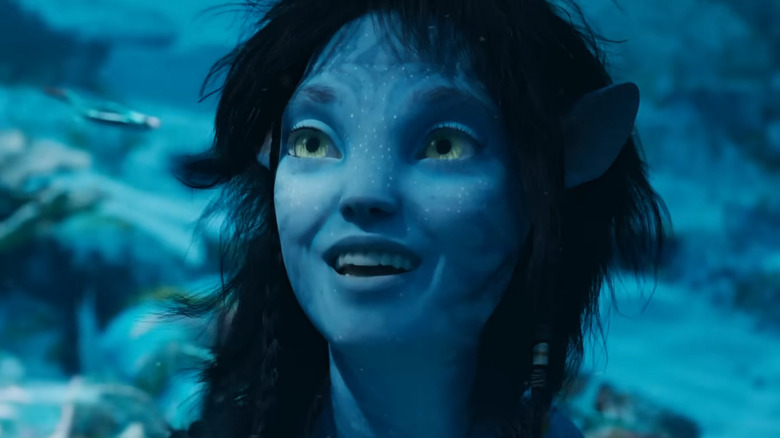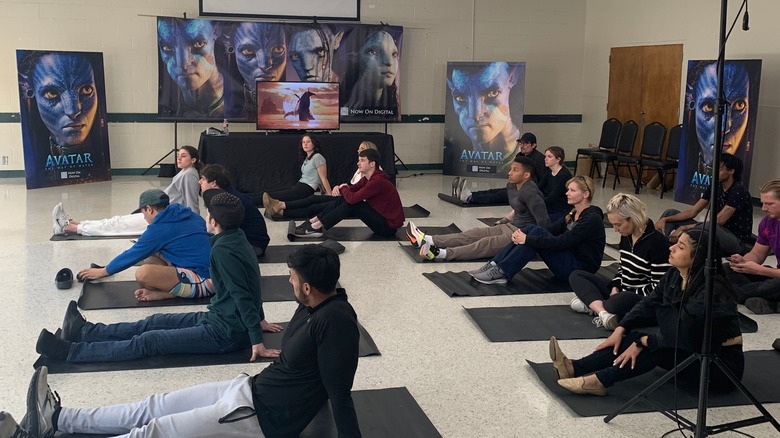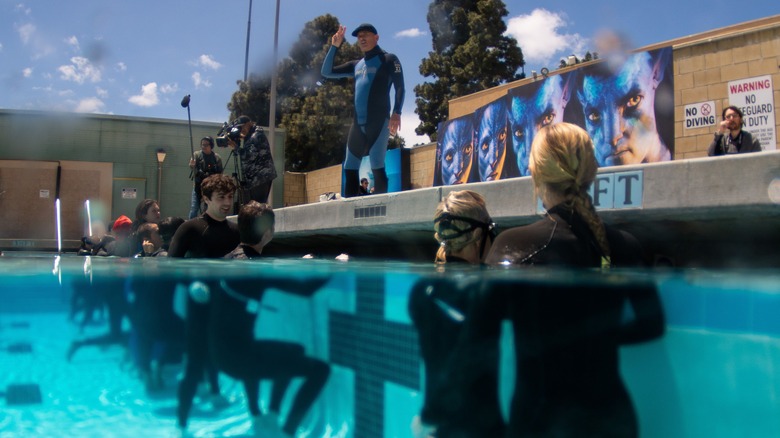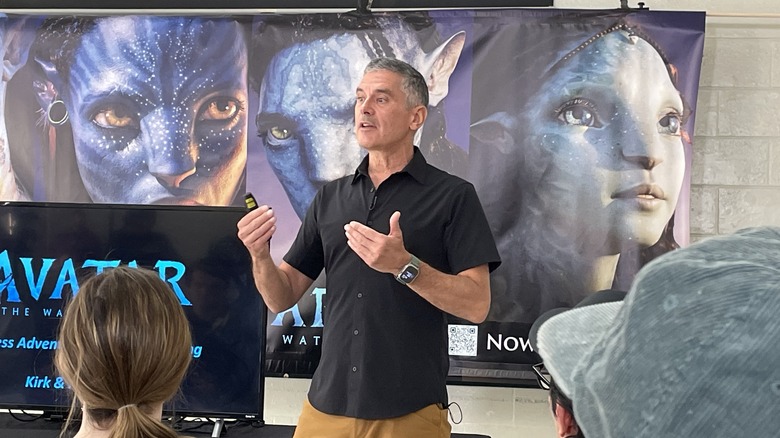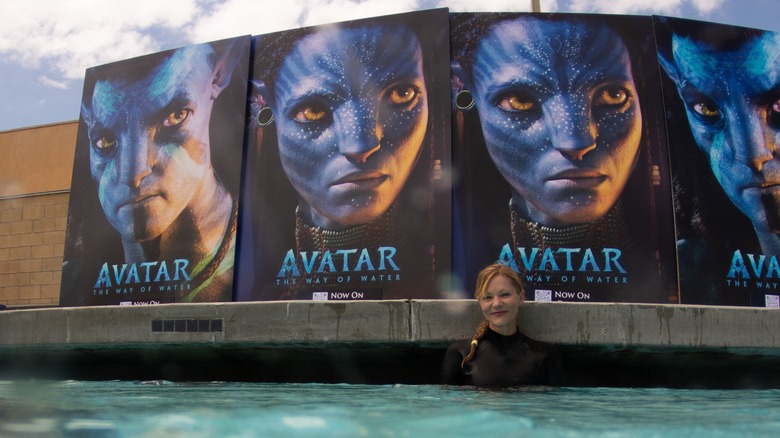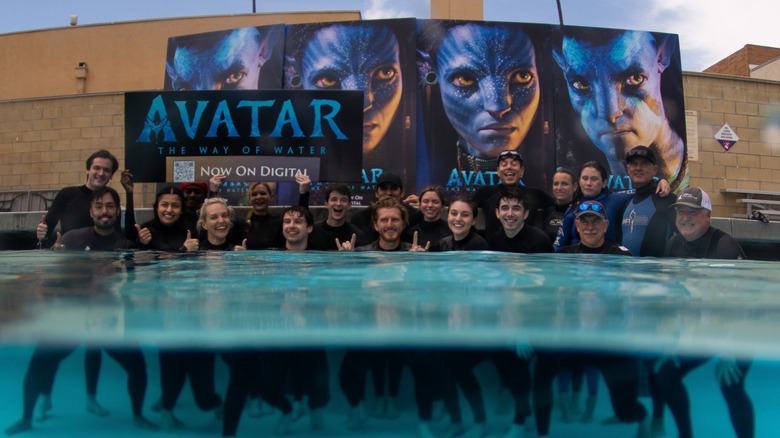I Learned To Hold My Breath Like The Actors In Avatar: The Way Of Water
"Avatar: The Way of Water" is out on digital. Perhaps you've heard of it? The long-awaited sequel to 2009's "Avatar" by James Cameron made almost $2.5 billion at the box office. It continues the story of the Sully family as they hide out from the humans of the RDA, who have returned to Pandora after years away. The family finds sanctuary with the Metkayina, a water-based group of Na'vi who have developed physical adaptations for swimming.
You may have heard the stories on-set of the actors holding their breath underwater, aka freediving, for a very long time. This includes Kate Winslet — who played Ronal, one of the Metkayina — holding her breath for a whopping seven minutes and 15 seconds. In fact, all the swimming scenes were done "wet for wet," meaning that they were all shot underwater. That meant the actors had to learn to swim under the surface for a long time without scuba gear, which would cause too many bubbles. Those bubbles read on a camera, similar to the motion capture dots that the VFX artists need to render the final shots.
There is a method to this breath-holding freediving technique, and it's fascinating. I recently attended an event at a local Los Angeles swimming pool to celebrate the digital release of the film, and Kirk Krack, Marine Unit and consultant on "Avatar: The Way of Water," taught us the same techniques that the actors learned. We started on land, then moved into a pool.
Do not try any of this at home. We were being supervised, and there were a lot of safety precautions, including not doing this alone. If you want to attempt freediving and breath holds, please check in with Krack's company, Performance Freediving Academy to see where to get trained.
Overcoming your brain
Kirk Krack created the first Breath-Hold Surf Survival (BHSS) course. He worked with Tom Cruise and Rebecca Ferguson on underwater techniques for "Mission: Impossible — Rogue Nation," with Margot Robbie and her stunt double for "Suicide Squad, and even magician David Blaine. He also brought along his teen daughter Kaila (right under the monitor screen in the picture above), who doubled for Trinity Jo-Li Bliss, the actor who played Tuk, Jake (Sam Worthington) and Neytiri's (Zoe Saldaña) youngest daughter in the film.
Krack was on set every day and in most of the underwater scenes for safety, though you can't see him in the final shots. He wasn't wearing motion capture dots but was on set to aid the actors he trained. He was assisted at the event I attended by Jurgen Heitmann and Andy Walshe from The Liminal Collective, a company that works to expand the limits of human potential and athletic performance.
He began with a presentation about how it all works, and the idea of overcoming primal fears like drowning and the body's response to lack of oxygen. We were told that the world record for breath-holding is over 11 minutes and that Krack himself had done it for seven. We learned about how the body responds to carbon dioxide building up in the body and how it creates carbonic acid. Our brains notice this acid and tell us to breathe to move it through. Nothing terrible will happen if we hold our breath for that long (with all safety precautions in place, and again, do not try this without instruction). What we were learning is how to overcome the body's normal signals. Let me tell you, it wasn't easy, but it's wild to try.
Breathing ... so you don't have to breathe
We began by doing a series of sets of something called a "breathe up." You breathe into your diaphragm, then into your lower lungs and ribs. You breathe in, hold for a count of two, breathe out slowly for 10 seconds with an audible sound, then hold for two. You do this for a while, depending on how long your ultimate breath-hold goal is for. We did it for a minute for some, and two minutes for others. Then we did a "purge," which was a deep breath into the diaphragm, then the lower lungs and ribs, then we top it up to the point that your shoulders rise up. Then you release it for four pushed exhales. You breathe normally for 10 seconds, then take a deep inhale and begin your breath-hold. All of this is to manipulate your system into being calm and relaxed enough not to breathe for an extended period.
We did a one-minute hold, then a two-minute, and then a two-and-a-half-minute hold while lying on yoga mats on the ground. As we held our breath, Krack took us through relaxation techniques, inviting us to relax individual body parts as well as the mind.
I was pretty good at it on the yoga mat! Oddly enough, the shorter holds cause your body to give you more signs to breathe. My body twitched in the one-minute hold, but not in the longer ones. In the longest hold, it felt like I could have gone on with little problem. Of course, that didn't mean anything to my brain in the water, and there are several reasons for that.
Water is not the same
For the next phase of the class, we partnered up and put on our wetsuits. Look, I am a baby about the cold. I have something called Raynaud's Phenomenon, which basically means I have crappy circulation. I get cold very easily, and my fingers and toes just go white and numb when it's below 68 degrees. That's all to say that the wetsuit didn't keep me warm.
My partner went first as we stood in the pool. We were instructed in buddy safety, which includes getting full signals from the other person from underwater, holding your hand in front of their face so they don't bang their face on the side of the pool, and doing the counts for them.
My partner's final hold was cut short because of the cold temperature, leading Andy Walshe — who was behind us in the pool — to tell us that once the shivering starts, your body's need for oxygen goes up 500 percent! When I began my own attempt, I was already shivering like mad. I was able to hold for one-and-a-half minutes underwater, but it wasn't anything like it was on land. Put me on a yoga mat, and I can relax the rest of my body, but in the water, shivering and watching, it's incredibly difficult.
It didn't occur to me until I returned from the event that I hadn't been swimming with my head underwater since I had a near-death experience during two surgeries. This is a primal fear I didn't have before, that sort of kicked in when I had to let go and float without breathing.
Taking it into the dry world
One thing Krack told us is that the segmented breathing technique that involved breathing into the diaphragm and the lower ribs, holding for two, exhaling for ten seconds, then holding for two again, was beneficial to attempt every day. Now, when I say this, I don't mean in the water. (Yes, that was another safety warning.) He spoke about doing this during the day twenty times, doing some in the morning and the evening split into sets of ten, as it calms the nervous system and helps you relax. Setting aside time to calm down and relax is something I'm familiar with since I meditate daily. I can speak to its benefits, which include reduced anxiety and better technique when I exercise.
I'm also a marathon runner, and even though I do meditate, doing something like this where you hold your breath for a long time was really strange for my body. I spend a lot of time running long distances, where the big thing is breathing and not holding your breath (the same goes for my gym training).
To be completely truthful, I was a little frustrated with myself for not being able to hold my breath as long underwater. That led me to attempt it again at home. (I was practicing on land, and there was someone with me. Safety warning again, friends.) I was able to get my breath hold up to three-and-a-half minutes. This was on land, not in the water, though, which I would love to attempt again ... with an instructor. I also think I was able to do it because I wasn't in the water, floating with nothing to hold onto, because I didn't feel as helpless (which reminded me of the surgeries).
Respect for the actors who did this
The way the human body works is fascinating to me. The idea that we can manipulate our own systems to do things we wouldn't normally do and override signals that we don't need at the moment is crazy. I mean, I was familiar with how breath can change moods and feelings from both meditation and running (which is the one thing I can always count on to calm me down), but this is a whole new level of it.
One thing Krack mentioned several times was that the techniques becoming almost second nature after extensive training allowed the actors to stop thinking about them and focus on acting. Some of them, he said, were so into the whole thing so much that they didn't want to stop. He said that Sigourney Weaver, who played Kiri, would be over at the tank even when she wasn't shooting. Bailey Bass, who played Tsireya (Reya), started out by not holding her breath for long and being at the bottom of the pack. After a while, she ended up being able to hold her breath for a long time and wanted to stay in the tank as well.
Having attempted this, I have an enormous amount of respect, not just for the actors who learned the techniques, but for Krack, who makes this seem very easy and comfortable. I may admit to having a few nightmares the day before, but despite my failed attempt to become a Metkayina, I'm pretty proud of holding my breath on land for three-and-a-half minutes. I'm definitely going to look for more instruction, and I'm going to try the breathe-up technique each day to get better at this.
"Avatar: The Way of Water" is out on digital right now.
